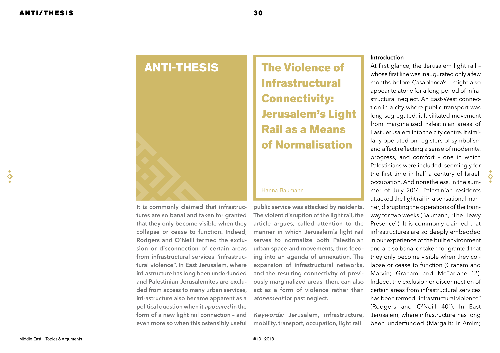The Violence of Infrastructural Connectivity: Jerusalem’s Light Rail as a Means of Normalisation
It is commonly claimed that infrastructures are so banal and taken-for-granted that they only become visible when they collapse or cease to function. Indeed, the exclusion or disconnection of certain areas from infrastructural services has been termed ‘infrastructural violence’. In East Jerusalem, w...
Tallennettuna:
| Julkaisussa: | Middle East - Topics & Arguments |
|---|---|
| Päätekijä: | |
| Aineistotyyppi: | Artikel (Zeitschrift) |
| Kieli: | englanti |
| Julkaistu: |
Philipps-Universität Marburg
2018
|
| Aiheet: | |
| Linkit: | Linkit |
| Tagit: |
Lisää tagi
Ei tageja, Lisää ensimmäinen tagi!
|
| Yhteenveto: | It is commonly claimed that infrastructures are so banal and taken-for-granted that they only become visible when they collapse or cease to function. Indeed, the exclusion or disconnection of certain areas from infrastructural services has been termed ‘infrastructural violence’. In East Jerusalem, where infrastructure has long been underfunded and Palestinian Jerusalemites are excluded from access to many urban services, infrastructure also became apparent as a political question when it appeared in the form of a new light rail connection – and even more so when this ostensibly useful public service was attacked by residents. The violent disruption of the light rail, the piece argues, called attention to the manner in which Jerusalem’s light rail serves to normalise both Palestinian urban space and movements, thus feeding into an agenda of annexation. The expansion of infrastructural networks, and the resulting connectivity of previously marginalised areas, then, can also act as a form of violence rather than ‘atonement’ for past neglect. |
|---|---|
| DOI: | 10.17192/meta.2018.10.7593 |
 Publikationsserver
Publikationsserver